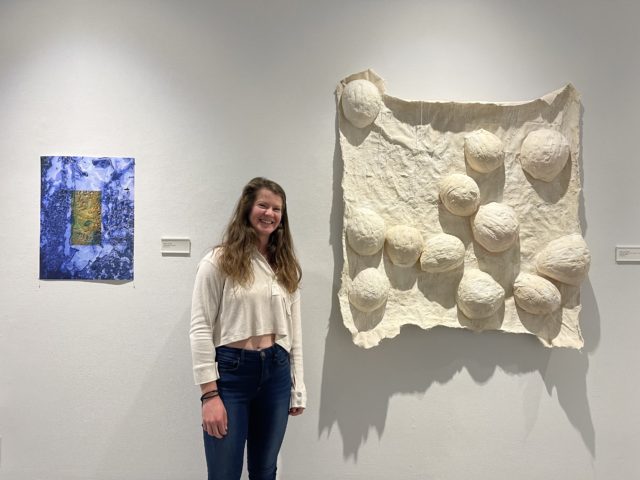While working on a small farm in Ferrum, Virginia last summer, I consumed solely organic products and foods, and immersed myself in the land through regenerative agriculture and sustainable land practices. This fundamentally altered the way I interpreted my artistic practice and ignited a switch in my material choices from paint and digital collages to eggshells, flour paste, and reused paper towels. Now composed of mostly biodegradable and organic materials, my most recent work explores themes of accumulation, sustainability, and a greater sense of connection with the earth. All in One Basket is a journey of my transformation in material choice as I gained awareness of the environmental implications of a sustainable practice. From working on the farm, collecting eggs every morning, and learning how to make bread from scratch, these hands-on experiences shaped the process of how I gather my materials and apply them to the work itself. My connection with the surrounding environment feels strengthened through scavenging materials in nature and repurposing items from daily use. This transformation has led to a practice that distills nature through minimalism and an exploration of raw materials.
Hometown?
Myrtle Beach, SC.
What is your primary medium?
I work with multiple mediums, such as oil paintings and digital collages, but my most recent work is mixed media created from flour paste, recycled paper towels and eggshells. Over the past year I’ve collected over 500 eggshells from friends, family, faculty, and staff that I have been using directly in my work.
What was the inspiration for your show?
My show is inspired by my experiences working on a farm last summer. There’s been an obvious transition from medium choice based on my interactions with my surrounding environment as I’ve become more conscious of my carbon footprint. I’ve been largely inspired by the work of Louise Bourgeois, Eva Hesse, and Yayoi Kusama in exploring unconventional materials with a minimalistic approach.
What does the title of your show mean?
Eggs have a mysterious, intricate, and versatile nature about them. For centuries, eggs have appeared in art from many cultures and have been connected to themes of fertility, protection, and fragility. However it’s the memories associated with eggs that influence my work.
Freshman year of college, I created a quote board with my friend to document all of our funky and unusual sayings. And many expressions that were simply not correct always made the board. One morning at breakfast, she frantically said to me, “All of my eggs aren’t in one basket. Where are my eggs?” This phrase made the quote board and it still makes me chuckle when it comes up in our conversations today. This connects a lot to the work I create because even though I feel pressure to stick with one medium, I feel the most successful leaving my comfort zone and exploring new ways to challenge myself, whether that be in material choice, scale, or process. Creating room for spontaneity and true self-expression, void of judgment, is an important aspect of my work.
During my time on the farm, I began each morning at 7 AM, feeding and giving water to all of the animals, including chickens, cows, pigs, turkeys, and rabbits. I was also responsible for collecting the eggs from the chicken coops every morning. Over my three months on the farm, I began noticing less and less eggs. I began finding eggs in sporadic areas throughout the property — in the tractor, in shady areas of the barn, and on top of buckets. On one of my last days on the farm, I found a stash of eggs in the garden underneath a bush of daisies. This experience of searching for eggs was nostalgic, reminding me of family Easter egg hunts with my seven siblings growing up. This began my fascination with eggs and is why they have become so pertinent in my work.
What do you feel is the most significant piece in the exhibition and why? What is your favorite piece and why?
The piece Easter Bread is an abstract interpretation based on a family tradition of homemade bread my mom baked every year during Easter time. Easter Bread is composed of braided bread in the form of a wreath with vibrant, dyed eggs stuck in between the twists. This was the first work I had created based or inspired by eggs and was completed about two years ago. Fast forward to this past year where I began physically using the ingredients of Easter Bread in my work, especially the piece Rate of Earth Decay, in which I used flour, water, and eggshells.
How will art and the process of making continue to play a role in your life after graduation?
The skills I’ve gained through my art practice will always stick with me no matter what field I end up pursuing. I would love to find ways to use my art as a means to continue growing my connection with the earth while also building a community. I want to explore new ways to continue developing a sustainable practice and work to lower my carbon footprint and hopefully encourage others to do the same through daily and actionable steps in and out of the arts.
View the Virtual Tour.
View Liz’s Artist Talk.

